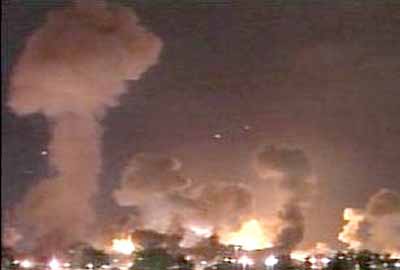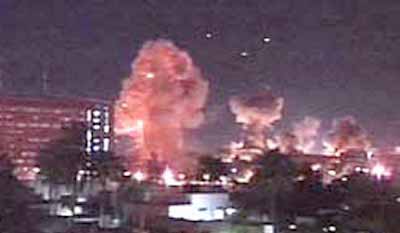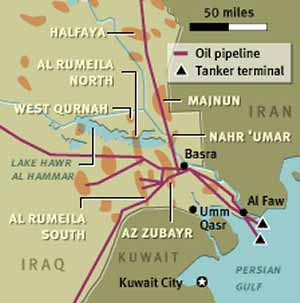Shock and awe’ air strikes
launched
March 21, 2003 01:45
PM EST


Massive cruise missile strikes took out
dozens of buildings in
Baghdad and across Iraq on Friday as the
Pentagon began its
promised “shock and awe” aerial campaign.
Fires and huge
plumes of smoke filled the skies of downtown
Baghdad
|
AT THE PENTAGON, Gen. Richard Myers,
chairman of the joint chiefs of staff, said that “a massive air campaign
throughout Iraq” had been launched.
“Several hundred military targets will be hit over the coming hours,”
he said.
Defense
Secretary Donald Rumsfeld said U.S.-led forces had intensified talks with
individual Iraqi military units over surrender conditions, though no direct
country-to-country talks on a general surrender were under way.
He
said it was possible the United States “has not been sufficiently persuasive.”
In
Baghdad, Arnett reported only an hour earlier that many missiles had struck
the presidential compound of Iraqi President Saddam Hussein.
“It’s
gone up totally in smoke ... it’s just blown apart,” said Arnett, who is
reporting for National Geographic Explorer and NBC News.
He
estimated that 25 buildings were blown up in a matter of 10 minutes. Other
buildings that were on fire included offices of the Council of Ministers
and a government bunker.
|
One U.S. official told The Associated Press
that hundreds of sorties were planned against targets in other Iraqi cities
as well. The source described it as “A-Day,” meaning Aerial Day.
In
Kirkuk, northern Iraq, MSNBC.com’s Preston Mendenhall saw aircraft in the
skies. Other witnesses saw antiaircraft fire in Mosul.
One
U.S. official involved in military planning told The Associated Press that
B-52 bombers had been scrambled en masse from a base in England and would
launch cruise missiles in a strike that would be bigger than anything seen
thus far in the conflict.
In
the early hours of the war, the U.S. launched two rounds of sea-based cruise
missile attacks against Baghdad, but sent only two Stealth bombers over
the city.
TWO MARINES DIE IN COMBAT
Also Friday, two U.S. Marines were killed
in combat, Pentagon officials said. One of the slain was from the U.S.
1st Marine Expeditionary Force, Lt. Col. Neal Peckham, a British military
spokesman, said Friday.
Details
of the incident were unclear. However, a fellow soldier, along with an
Associated Press reporter, said the Marine was shot in the stomach while
his company was patrolling around a burning oil pumping station in southern
Iraq.
The
second Marine was killed during fighting to secure the Iraqi port town
of Umm Qasr. The two Marines were the first combat deaths in the war.
On Thursday, coalition forces suffered
their first known noncombat casualties of the war when 12 U.S. and British
troops were killed as a U.S. Marine Corps helicopter went down inside Kuwait.
The
officials said the helicopter was a CH-46E Sea Knight medium-lift craft
that did not come under hostile fire. It carried eight British commandos
and a crew of four Americans. None survived.
Nearly
300,000 U.S. and British forces have been deployed in and around Iraq to
overthrow Saddam, who defied a U.S. ultimatum to go into exile by Wednesday
or face military action.
AIRFIELDS TAKEN
The
allied forces concentrated their attack on southern Iraq, but U.S. officials
said Friday that American forces also seized important airfields in the
west of the country.
The airfields, known as H-2 and H-3, in
far western Iraq, were taken without much resistance from Iraqi troops,
defense officials said on condition of anonymity. But they called control
of the installations “tentative.”
And while it appeared that the British
and U.S. forces were making ground Friday, the Iraqis weren’t giving up
without a fight.
The
First Marine Division needed air support to suppress Iraqi mortar and small
arms fire while seizing Route 80, which leads from Kuwait to Basra.
“Every
now and then they pop off to let us know they’re still there,” Lt. Col.
Steve Holmes, a Marine in charge of clearing berms for troops and armor
to enter Iraq.
Supported
by Cobra attack helicopters and howitzers, Marine tanks and armored vehicles
rolled down Route 80 through the demilitarized zone between Kuwait and
Iraq.
 |
PORT CAPTURED
Myers
said U.S. and British forces had pushed 100 miles into Iraq from Kuwait,
along the way capturing Umm Qasr, which is about 20 miles inland from the
tip of the al-Faw peninsula and which handles the export of Iraqi oil supplies.
Reuters
filed a photo of a Marine raising the Stars and Stripes over the port.
Some time later, Marines returned and removed the flag. No reason was given,
but Washington has consistently stressed that U.S. and Britisn forces want
to liberate Iraq, not occupy it.
The
ground attack on Umm Qasr followed a night of intense shelling by U.S.
and British forces in the area.
|
Taking Umm Qasr now gives U.S. and British
forces access to a port for military and humanitarian supplies.
Off
the coast of Iraq, U.S. warships intercepted an Iraqi ship carrying 130
mines as well as weapons, Myers said Friday.
ALLIED CONFIDENCE
The apparent early gains coupled with
signs of disarray within the Iraqi leadership bolstered political and military
leaders of the coalition forces.
At
Central Command in the gulf nation of Qatar, the main spokesman for the
British forces adopted a confident tone, telling reporters that he expected
forces to reach Baghdad in less than a week.
“If
I were a betting man, which I’m not — hopefully in the next three or four
days,” Capt. Al Lockwood said.
In
a boost to the U.S. administration, a new poll showed that about two-thirds
of Americans approve of President Bush’s handling of the war and think
he did enough diplomatically before invading Iraq.
The
ABC-Washington Post poll found he president’s job approval rating at 67
percent, up from pre-war polls that showed his approval level ranging from
the mid 50s to about 60 percent.
For
the second straight day, Bush summoned reporters and photographers into
a White House meeting Friday but did not field questions. He did not offer
details about Saddam’s whereabouts or the status of the Iraqi regime, but
said, “We are making progress.”
SADDAM’S FATE
The whereabouts of Saddam Hussein remains
a mystery.
U.S.
officials had suggested he might have been killed or injured in the opening
foray of the conflict, a strike of a building in the Iraqi capital where
the president and his inner circle were believed to be meeting.
On
Friday, U.S. intelligence officials said an analysis of TV footage showing
Saddam Hussein, broadcast after the first U.S. strike, indicated it was
the Iraqi leader speaking — although they suggested the tape could have
been recorded in anticipation of the strike.
Other
officials, speaking on condition of anonymity, said they had strong indications
no one was in charge of Iraq’s government and armed forces. They didn’t
offer evidence to back this claim.

|


